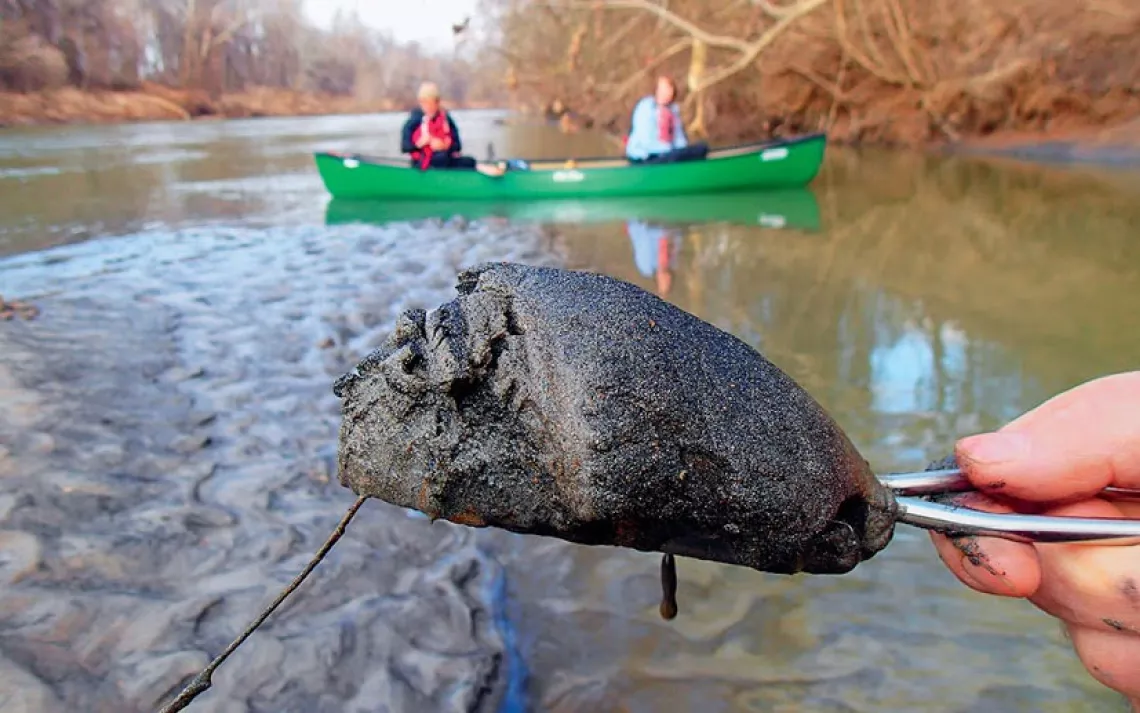Unlike its neighbors, North Carolina has a soft spot for toxic coal ash
North Carolina is worried about bathrooms. Toxic coal ash, not so much.

Photo by Dan River Basin Association
Two and a half years ago, a security guard at a shuttered coal-fired power plant in North Carolina owned by Duke Energy made a devastating discovery: A stormwater drainpipe running under a pool that stored leftover coal ash had ruptured. Nearly 40,000 tons of the toxic muck spilled into the Dan River.
Local environmental groups had been scrutinizing the state's coal ash ponds ever since a 2008 spill in Kingston, Tennessee, had unleashed more than a billion gallons of coal slurry, clogging rivers and burying homes. "We looked around and said, 'Wow, we've got a lot of these here in North Carolina,'" recalls Catawba Riverkeeper Sam Perkins. Duke Energy has 33 ponds around the state, "all leaking," says Molly Diggins, the Sierra Club's North Carolina state director.
Although the ash contains lead, mercury, arsenic, and hexavalent chromium, it's never been listed as a hazardous material, and storage wasn't regulated until 2014, when the EPA finally started requiring lined pits. Duke maintains that the ash is no more toxic than rocks and dirt, which also contain heavy metals. North Carolina's environmentalists disagree. "The metals have been concentrated in the ash and can pose serious health problems when they contaminate drinking water sources," Perkins says. Contaminated groundwater has been found at every one of the 33 sites. In 2013, the Southern Environmental Law Center, representing 12 groups (including the Sierra Club), targeted each coal ash pond for violating the federal Clean Water Act and state water laws, starting with a demand that cleanup begin within 60 days.
That same year, however, Pat McCrory, the former mayor of Charlotte and a 28-year employee of Duke Energy, became governor and set about remaking the Department of Environmental Quality. Amy Adams, a DEQ supervisor and second-generation employee, quit in protest over staff and funding cuts that she said left employees unable to do their jobs protecting the environment. "I have completely lost faith in the department," she says. Adams subsequently joined Appalachian Voices, one of the groups suing over coal ash.
A pattern established itself in the first two cases brought by the environmental coalition. On the 59th day after the demand letters were sent, the DEQ marched in, took over the lawsuits, and quickly arranged a settlement with the energy giant: a fine of less than $100,000, with no mandate to clean up.
Then the pipe under the Dan River site gave way, coal ash became a national story, and federal investigators swooped down. In 2015, Duke pleaded guilty to nine violations of the Clean Water Act and agreed to pay a $102 million fine, the largest in the state's history.
Even then, North Carolina showed a soft spot for Duke. The company's CEO dined privately with McCrory at the governor's mansion while negotiations on coal ash cleanup were underway. A draft report by DEQ scientists recommending that all coal ash sites be designated as high risk and requiring complete ash removal was altered by higher-ups to designate only 20 sites—which happened to be the ones Duke had already agreed to clean up.
When the Republican-controlled legislature created a Coal Ash Management Commission, independent of the governor, to oversee the cleanup, McCrory sued for constitutional overreach—and won. He then dismantled the commission.
David Fountain, president of Duke Energy North Carolina, wrote in the Raleigh News & Observer that "special interests" were trying to scare people into believing coal ash was toxic. Fountain's tone concerned Frank Holleman, the Southern Environmental Law Center's lead attorney on the case. "You'd expect the president of a company that pleaded guilty to criminal pollution charges to show some humility, instead of attacking members of the public who drink water as a 'special interest,'" he says.
In May, more than two years after the Dan River disaster, the DEQ released its final recommendation: All the sites were designated as intermediate risk, meaning the ash had to be moved to lined landfills by 2025. But there was a catch—the agency asked for the right to revisit those designations in 18 months, at which time they could presumably be changed.
South Carolina has taken an altogether different approach. There, environmentalists sued to get coal ash pits removed, but the state didn't intervene. The courts ruled against the utilities, the state enforced the law, and all sites are now scheduled for cleanup. "South Carolina's utilities realized this was not a risk they wanted lingering in perpetuity," Perkins says. "They found value in mitigating this risk efficiently, and as a result didn't have to raise rates. South Carolina committed and moved forward. North Carolina seems to be in a state of denial."
This article was funded by the Sierra Club's Beyond Coal campaign (beyondcoal.org).
The article appeared in the September/October 2016 edition with the headline "State of Denial."
WHAT YOU CAN DO
Don't go backward on coal ash. In the wake of the Kingston and Dan River spills, the EPA put in place long-awaited restrictions on the storage of coal ash. However, coal-industry supporters in Congress continue to introduce bills and amendments to roll back these safeguards. Please call your senator and ask him or her to oppose any effort to undermine the EPA's coal ash disposal standards: (202) 224-3121.
 The Magazine of The Sierra Club
The Magazine of The Sierra Club



